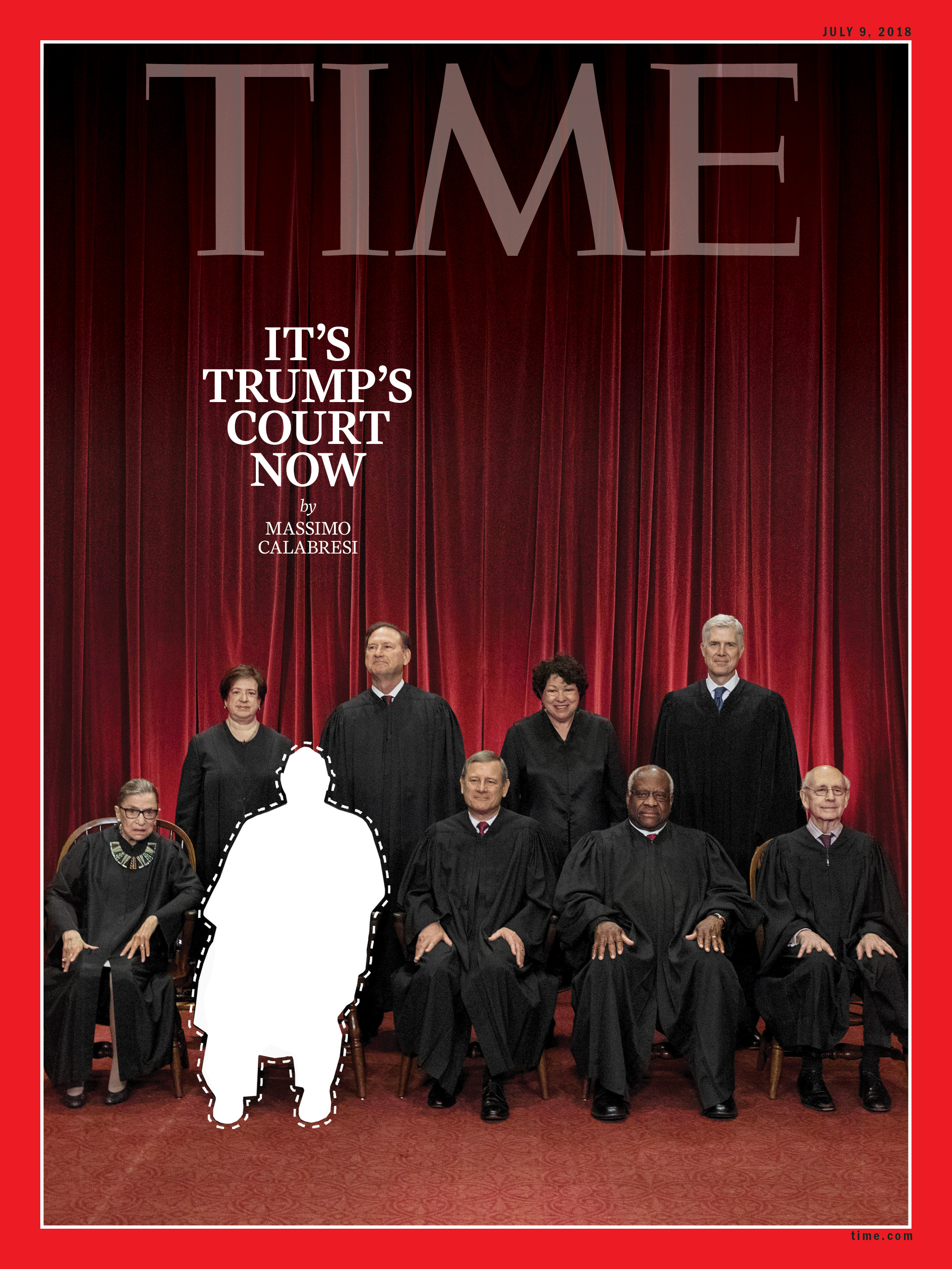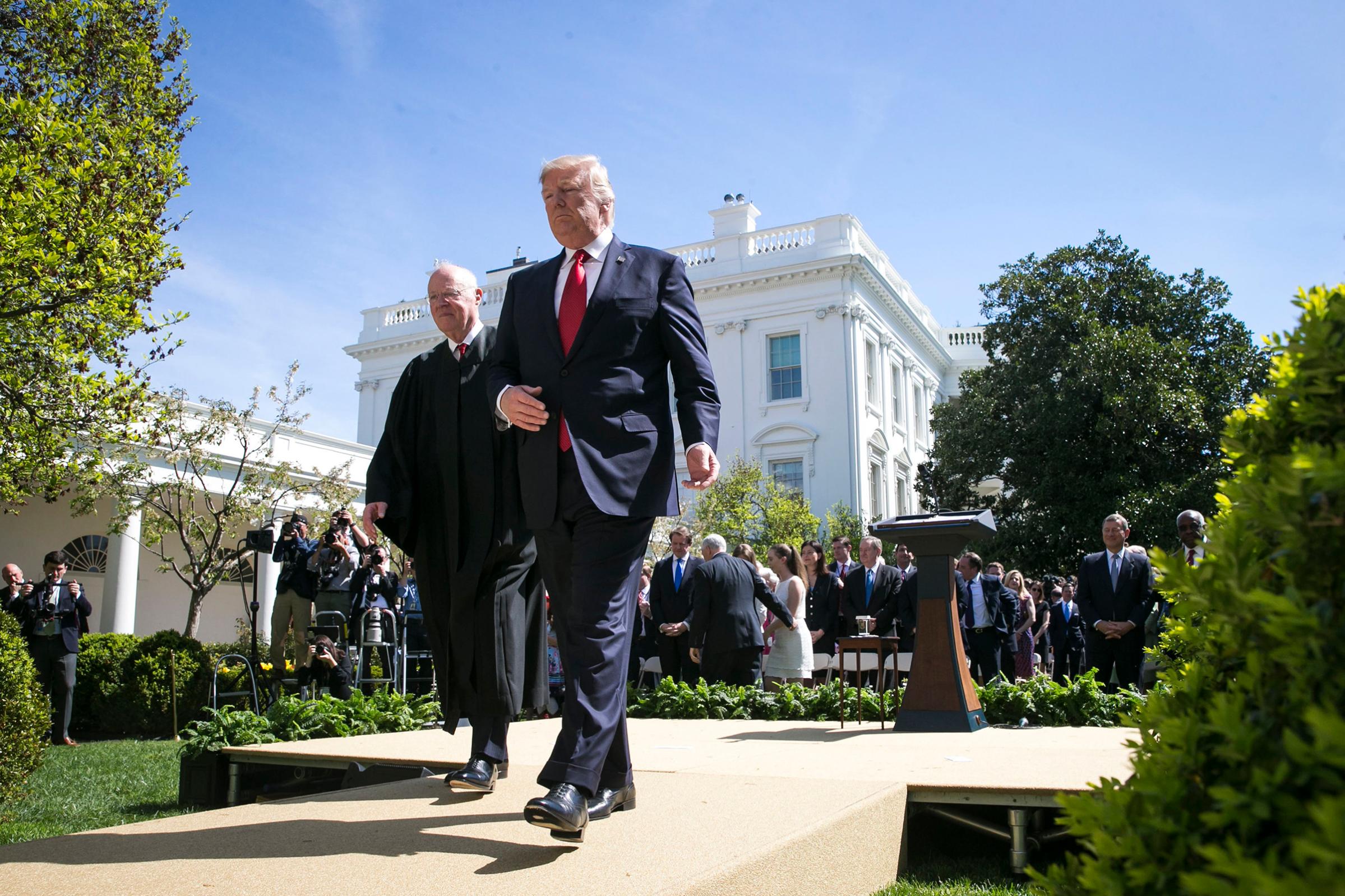For years, some of the most consequential discussions in America were held around a small round table in front of a window with a view across First Street to the Capitol building. It was there, in the pin-drop silence of his Supreme Court chambers, that Justice Anthony Kennedy convened his clerks each year to assign and analyze the cases that would come before America’s highest court in the coming months.
It was also where Kennedy would greet guests for private conversation. Courtly to the point of caricature, he would have his staff lay out white linen napkins and a cut-crystal milk jug, then serve tea. He would also salt his legal analysis with Shakespearean allusions, fresh in his mind from after-dinner reading at home with Mary, his wife of 55 years. Alternately self-effacing and grandiloquent, he talked about the books he was reading and what worried him about the law, the country and the world.
And it was there at that table, in the early morning after beating the Washington traffic into the capital, that Kennedy often wrestled with the thorniest issues America faced. Should abortion be legal and easily accessible? How could affirmative action be deployed to right the historic wrong of racism without becoming racist itself? Should gay people have the same rights as straight people?

If the image of quiet, contemplative debate seems anachronistic in these vituperative times, the contrast is even more poignant after the Justice’s latest decision. On June 27, Kennedy announced that he would step down from the court, taking with him the unique moderating role he has played in America for three decades. The last swing voter on the court, he sought–often to the frustration of everyone around him–to find compromise between competing ideals and, at times, ideologies.
What remained of that world is about to come crashing down. Some 30 minutes after the 81-year-old Justice met with President Trump in person at the White House, his resignation became news, and preparations for battle broke out across Washington.
Leonard Leo, Trump’s top outside adviser on judicial nominations, told TIME that the President could announce a nominee in the next two to three weeks. The timing would put Trump on track to potentially seat his second Justice by Oct. 1–the start of the next high-court term, and well before midterm elections could alter the Republican majority in the Senate. “I think that as long as the President sticks to the model that worked last time, which is to appoint someone like Neil Gorsuch,” Leo says, “that is the best recipe for ensuring some level of bipartisan support.”
Senate majority leader Mitch McConnell, who orchestrated the GOP blockade of President Obama’s nomination of Merrick Garland to the court on the grounds that a new Justice should not be confirmed in an election year, said he had no such reservations this time. As word of Kennedy’s resignation broke, McConnell convened a group of senior Republicans in his office to walk them through his plans to confirm Trump’s nominee this fall. “We will vote to confirm Justice Kennedy’s successor this fall,” McConnell said.
Immediately following Kennedy’s decision, which had been rumored for months, conservative groups sprang into action. Americans for Prosperity, backed by billionaire brothers Charles and David Koch, turned the keys on a seven-figure grassroots campaign to build support for Trump’s nominee. The political machine is ready to run ads, knock on doors and make phone calls to pressure Senators. The effort also aims to energize conservatives who might otherwise have sat out this November’s elections but now see a solid conservative majority on the nation’s highest court as more than a theoretical prospect. “We knew this day was coming. We have plans on the shelf,” says a GOP official. “We are Republicans. This has been our dream for years.”
For many Democrats, it was a moment to mount the barricades. In an election season when women are dominating Democratic primaries, the selection of a Justice who might vote to overturn Roe v. Wade would put massive pressure on even traditionalist Senators to filibuster. “Whether it’s women’s issues or discrimination against religion or the LGBT community–all those are at risk,” Senator Ben Cardin of Maryland told TIME. “The tactics that the Senate majority leader used denied the Supreme Court its proper membership.”
The partisan agonists are not wrong about the significance of the moment. Over the years, Kennedy had been a critical vote on everything from gay rights to free speech and even the 2000 presidential election. His replacement with a reliable conservative could shift the country’s top court to the right, likely making abortion less available, affirmative-action programs more limited and executive power more expansive. “This will be,” predicts Nan Aron, head of the liberal judicial group Alliance for Justice, “the most significant fight over a Supreme Court nomination in decades.”
Kennedy’s willingness to cross party lines was never as great as some liked to believe. He was, after all, a true Republican in the mold of Ronald Reagan, who appointed him. But the moderation that gave heart to liberals has roots in Kennedy’s upbringing in the cozy neighborhood of Land Park in Sacramento, a picture-perfect family enclave in midcentury California. Kennedy’s father, known as “Bud,” was a successful lawyer and lobbyist, and he and his wife “Sis” regularly hosted the capital’s civil servants and politicians on their back patio, with its citrus trees and small lawn.
The bookish young Kennedy looked up to these charismatic figures, and a happy childhood with friends in the neighborhood offers a particular lens on his jurisprudence. His father’s work, which he eventually took over after graduating from Stanford and then Harvard Law School, was very much embedded in the freewheeling influence peddling of the California legislature. Some have seen in Kennedy’s resolute opposition to constraints on campaign-finance spending, including his opinion in the Citizens United case, an echo of his own work from that time.
There were other influences too. Kennedy was set on his path to the court by an unlikely figure. Gordon Schaber was an influential lawyer in Sacramento and got to know Kennedy through his work. He later recruited Kennedy, to teach constitutional law at the night school he was transforming into a respected institution. It was from there that Kennedy found occasional work advising on tax law and other matters for Governor Reagan. After Kennedy became a pivotal vote on gay rights on the court, it emerged that Schaber had lived the difficult life of a closeted gay man. Kennedy later spoke of Schaber’s bravery with admiration at his funeral.
When two of Reagan’s more ideological nominations to the Supreme Court went down in 1987, Reagan tapped Kennedy, whom he had suggested that President Ford appoint to the Ninth Circuit Court of Appeals 12 years earlier. Colleagues soon found Kennedy to be an odd combination of bombast and self-effacement. He famously infuriated Antonin Scalia with his high-minded writing. Kennedy in one famous decision spoke of the “mystery of human life,” only to see it become a joke in Scalia’s dissent. But few ever doubted that Kennedy wrestled honestly with the issues at hand.
“There were very few easy cases for Justice Kennedy,” says Michael Dorf, a former Kennedy clerk who is now a law professor at Cornell. “That’s not just because he was sort of in the middle ideologically, but because he wanted to approach each case with an open mind.”
His departure sets up a difficult decision for democrats. The party’s liberal base is eager for a confrontation over any Trump nominee. But the moderate voters the party needs to win in November may prefer compromise. The backlash could be fierce, top Democrats warn. On the other hand, “anything that suggests Roe is on the table sends suburban women running from the Republican Party,” says one Democratic strategist. “Trump may make a play for the base, and that is only upside for us.”

Trump assured the public on June 27 that his nominee would come from the same list of 25 judges that he started writing during his campaign, an unusual gambit that allies credit for helping to coax skittish conservatives into backing him. Two of those judges, Thomas Hardiman and Raymond Kethledge, were finalists for the nomination that went to Gorsuch and are likely to be considered again. Brett Kavanaugh, a judge on the D.C. Circuit (and a prep school classmate of Gorsuch’s), is another possibility.
Whoever emerges will join a court that hasn’t been immune from the country’s increasing polarization. Where once the clerks of Justices socialized, in recent years, they’ve clashed. Ruth Bader Ginsburg and Scalia used to go to the opera together. Now the only time some Justices see each other is at their weekly conference or on the dais in the ornate hearing room.
If Kennedy returns to Land Park, he will find the world there has changed too. But at least one lingering demon may have been exorcised.
Not all of Kennedy’s childhood memories are positive. One involves a young Japanese-American playmate who owned a samurai doll that was kept in a glass case. Kennedy thought it was a funny toy you couldn’t play with, but one day a knock on his family’s door revealed his friend, weeping, with the doll in his hands. He handed it to Kennedy before running away. Kennedy later learned the boy had been sent to an internment camp for Japanese Americans, a national disgrace that was later codified into law by the court’s Korematsu decision.
Kennedy’s coda may end up being the correction of Korematsu. The day before he announced his retirement, the court issued a deeply divided ruling on Trump’s ban on migrants from largely Muslim nations. But it united on one issue of moral conviction. In his majority opinion, Chief Justice John Roberts said ‘Korematsu was gravely wrong the day it was decided, has been overruled in the court of history, and–to be clear–‘has no place in law under the Constitution.'” Justice Sotomayor, in an otherwise blistering dissent, called the court’s unanimous rejection of Korematsu a ‘formal repudiation of a shameful precedent [that] is laudable and long overdue.'”
Behind the high principle in those words, and more importantly, in the courts unanimous voice, it was hard not to see one last effort by Kennedy to unite the country.
With reporting by Tessa Berenson, Philip Elliot, Nash Jenkins, Abby Vesoulis and Justin Worland/Washington
More Must-Reads from TIME
- Why Trump’s Message Worked on Latino Men
- What Trump’s Win Could Mean for Housing
- The 100 Must-Read Books of 2024
- Sleep Doctors Share the 1 Tip That’s Changed Their Lives
- Column: Let’s Bring Back Romance
- What It’s Like to Have Long COVID As a Kid
- FX’s Say Nothing Is the Must-Watch Political Thriller of 2024
- Merle Bombardieri Is Helping People Make the Baby Decision
Contact us at letters@time.com